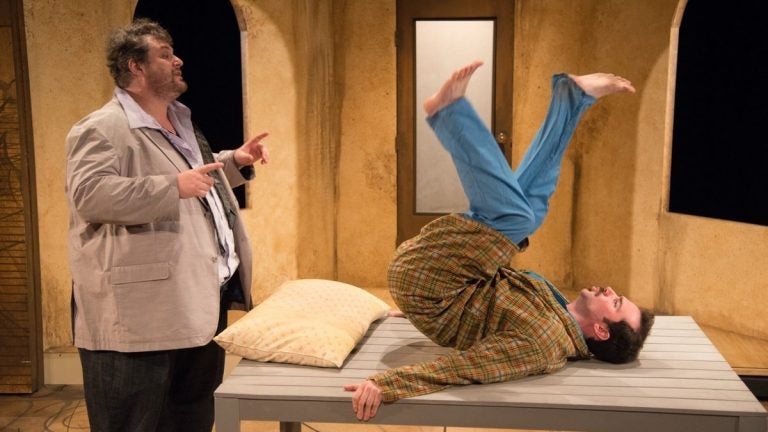Fringe Festival reviews: ‘Rhinoceros’ and ‘White Rabbit Red Rabbit’

Ethan Lipkin (left) and David Stanger in the Ideopathic Ridiculopathy Consortium's production of 'Rhinoceros.' (Photo courtesy of Johanna Austin)
A duo of reviews from Howie Shapiro; Idiopathic Ridiculopathy Consortium’s “Rhinoceros,” and “White Rabbit Red Rabbit,” from FringeArts.
RHINOCEROSThe breezy version of “Rhinoceros” from the city’s Idiopathic Ridiculopathy Consortium maintains some of its playfulness even at the end, when playwright Eugène Ionesco leaves one man standing alone against the rampaging creatures of the play’s title. But the production is by no means Ionesco Lite.
Rather, it’s a look at human nature that avoids a lecturish tone. In 1960, Ionesco wrote his play about a community whose residents turn into stampeding pachyderms. As an example of Theater of the Absurd, “Rhinoceros” is a guiding light for playwrights in a Fringe Festival: avant-garde, but highly focused and with a purpose. Ionesco wrote it to show the way a community adopts a faddish, reprehensible standard. In this case, he was referring to recent history — the Nazis and fascism.
At first the townsfolk resist the beasts or even deny their existence, and ultimately they join them. “Rhinoceros” is about throwing out the baby, the bath water and finally yourself.
The Idiopathic Ridiculopathy production casts Ethan Lipkin as Berenger, the weak-willed but good-hearted man confronting the herd of rhinos he once knew as neighbors, colleagues and friends. Tina Brock, who heads the stage company, directs this version and is responsible for its smooth feel. She has an able partner in Lipkin, a large presence (traditional for the role) who creates a likeable character that is more teddy bear than heavy hitter. We can identify with him easily.
Although you could attach current issues to the play, you can also see it as a fable simply about human behavior. Idiopathic Ridiculopathy does well to highlight the silly side of the residents, particularly their penchant for arguing over every aspect of an issue but not the issue itself. Steve Lippe plays an illogical logician, Bob Schmidt is a know-it-all naysayer, and Jerry Rudasill portrays a demanding boss whose reaction to the animals’ destruction is that the builders should have put a better staircase onto his offices. David Stanger is the self-righteous friend whose idea of a social interchange is all about him, and Kirsten Quinn is the understanding heartthrob. Rounding out the cast are Paul McElwee, Maryruth Stine, Thomas Dura and Michael Dura.
The 100-minute production, without intermission, unfolds on a clever set that has movable flaps to show different places. Erica Hoelscher designed it along with the costumes, whose rhino headpieces are nifty. Brock, the director, also designed the sound, which nicely throws the plot into rhino-attack mode whenever Ionesco calls for it.
_”Rhinoceros,” from the Idiopathic Ridiculopathy Consortium, runs through Sept. 21 at the Adrienne Theater, on Sansom Street between 20th and 21st Streets.
WHITE RABBIT RED RABBITI’m thinking we should all give in to our lesser judgment and declare a new movement called The Theater of Confusion. There seems to be more than a bit of it around. Iranian theater artist Nassim Soleimanpour has several ideas in his “White Rabbit Red Rabbit,” and he never explores them in a way that makes his thoughts whole. So we leave the show the way we enter it, not really knowing what it’s about.
I respect and sympathize with Soleimanpour’s plight – a plight that understandably will draw audiences to his side. The playwright can’t get out of Iran to see his work, and we can assume he’s subject to whatever other repressions that government imposes. He can’t get a passport because he never served two years in the military. So he’s written a first-person script that must be performed by other actors he’ll never see to audience responses he’ll never hear.
I don’t think the play alone can make audiences sympathize with Soleimanpour the way his own situation does. “White Rabbit Red Rabbit” is superficial and artificial, a piece that attempts to involve audience members in a life-or-death situation they’ll either shrug off or protest against.
That script has little bits for the audience to do – even the slightest instruction to an audience member is followed by Soleimanpour’s request for applause. The script begins with a story about a government that punishes a rabbit because its long ears block the sight-lines of other audience members sitting in a theater. It goes on to tell of an experiment involving the way hungry rabbits react to a rabbit who gets to eat. It ends with a theme about suicide that involves the actor who reads the script.
“White Rabbit Red Rabbit” also employs a conceit that’s supposed to give the audience and the actor a sense of adventure: Soleimanpour asks that on any given night, an actor who knows nothing of the script’s contents will come on stage, open a sealed envelope and read it cold. At the Philly Fringe Festival, the 13 actors performing during the run have signed pledges not to read or hear anything about the script, or converse with one another about it. The reading is supposed to last 50 minutes; I went to Saturday night’s show, which lasted about 75.
FringeArts has put together an impressive roster of readers, mostly from the acting community here and including David Morse, who opened the show Saturday afternoon. (The performers include WHYY’s “Morning Edition” host, Jennifer Lynn.) In the performance I saw, the actor K.O. DelMarcelle was the reader, and she gave a good sight-reading.
But I would have preferred to ditch the gimmick and get a fully polished reading instead, one that was rehearsed and even directed. While it may be cool to watch actors discover a role for the first time, it probably won’t result in a performance that enhances the writer’s work — especially a monologue that’s scattershot.
_”White Rabbit Red Rabbit,” from FringeArts, runs through Sept. 21 at Christ Church Neighborhood House, near 2d and Market Street to the west of the historic church.
Click through for information about the Philly Fringe Festival, which runs through Sept. 21.
WHYY is your source for fact-based, in-depth journalism and information. As a nonprofit organization, we rely on financial support from readers like you. Please give today.




